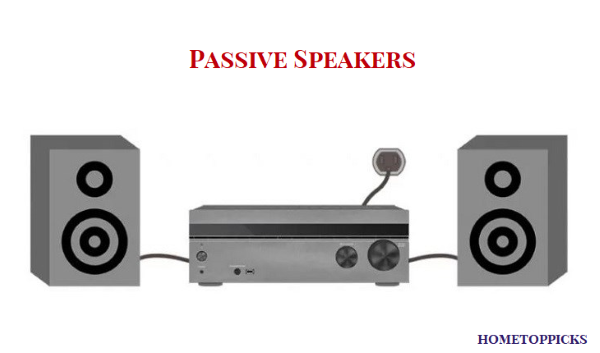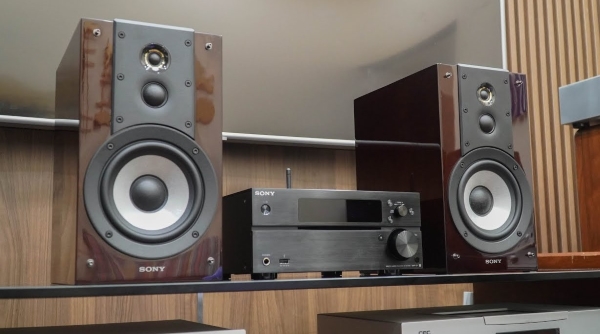Active vs Passive Speakers: Understanding 4 Key Differences
Are you in the market for a new speaker system? If so, you may have encountered the terms active and passive speakers. While they may seem like simple concepts, understanding the differences between these two speaker types is crucial when making an informed purchase decision.
In this blog post, we will provide you with a clear understanding of the key differences between active vs passive speakers. You’ll learn about the advantages and disadvantages of each type, as well as the most common use cases. By the end of this article, you can confidently choose the right speaker type for your audio setup.
Active Speakers
Enhancing Audio Experience and ConvenienceActive speakers have revolutionized the audio industry with their built-in amplifiers, versatility, and ease of use. In this blog section, we will explore the definition and features of active speakers and their advantages, disadvantages, and common use cases.

Definition and Features of Active Speakers
Active or powered speakers are audio systems incorporating built-in amplifiers within the speaker cabinet. It is a major advantage in the ultimate active vs passive speakers comparison.
Unlike passive speakers that require an external amplifier, active speakers are self-powered, facilitating a sleek and streamlined setup process.
These speakers are packed with essential features that enhance audio performance:
- Built-in amplifiers eliminate the need for an additional amplifier, optimizing efficiency.
- Multiple input options like Bluetooth, USB, and RCA for compatibility with various devices
- Advanced features like EQ controls, crossover settings, and wireless connectivity for tailored sound output
Advantages and Disadvantages
Active speakers offer numerous advantages that make them an appealing choice for audio enthusiasts and professionals:
- Improved Sound Quality: Active speakers provide a superior sound experience through their optimized amplifier-speaker integration, resulting in accurate sound reproduction across frequencies.
- Reduced Distortion: The built-in amplifier ensures optimal power delivery to the speakers, minimizing distortion and delivering dynamic, clean sound output.
- Ease of Setup: Setting up active speakers is hassle-free, with no separate amplifiers to connect. You can enjoy high-quality sound by connecting the power source and audio input.
- Versatility: Active speakers offer a wide range of input options, allowing users to connect various devices, including smartphones, laptops, and audio interfaces, using different connection types.
You may like: How to Connect a Bluetooth Speak with a Laptop
While active speakers present many advantages, there are some considerations to keep in mind:
- Higher Cost: The integrated amplifier and advanced features make active speakers more expensive than passive speakers. However, the added cost is often justified by enhanced convenience and performance.
- Limited Customizability: Active speakers do not allow for component upgrades or customization, restricting the ability to fine-tune the sound to individual preferences.

Common Use Cases
Active speakers are widely used in various scenarios where audio quality and convenience are paramount.
- Home Audio Systems: Active speakers are an excellent choice for home entertainment setups, providing immersive sound for music, movies, and gaming. Their compact size and wireless connectivity options are ideal for small to medium-sized rooms.
- Studio Monitors: Music producers and recording engineers often opt for active speakers as studio monitors. The accurate sound reproduction, coupled with the built-in amplifiers, helps in critical listening, precise mixing, and mastering.
- Live Performances: Active speakers find their place in live sound reinforcement systems, where portability, ease of setup, and robust sound are crucial. DJs, bands, and event organizers use active speakers for concerts, performances, and outdoor gatherings.
Active speakers offer enhanced audio performance, ease of use, and a range of features that cater to various audio needs. While they come with a higher price tag and limited customizability, their advantages make them popular for home audio setups, studio monitoring, and live performances.
Passive Speakers
Traditional Sound Reinforcement with Customizable PowerPassive speakers have long been a staple in the audio industry, offering a versatile and customizable sound reinforcement solution. In this blog section, we will delve into the definition and features of passive speakers, explore their advantages and disadvantages, and discuss common use cases.

Features of Passive Speakers
As the name suggests, passive speakers are audio systems requiring an external amplifier. These speakers do not have a built-in amplifier and rely on amplification from an external source. They consist of individual speakers, known as drivers, enclosed in a cabinet that serves as a protective and resonant housing.
Passive speakers offer flexibility in terms of amplification:
- Various input options, like speaker wire connections, allow you to connect to amplifiers and audio sources.
- Separate drivers for low, mid, and high-frequency drivers result in better sound reproduction across the audio spectrum.
Advantages and Disadvantages
Passive speakers come with their advantages, making them a popular choice for audiophiles, professionals, and enthusiasts in the active vs passive speakers debate:
- Customizability: Passive speakers are free to choose and pair with amplifiers that best suit individual needs and preferences. That allows for precise control over the sound output and the ability to upgrade or swap out components for improved performance.
- Versatility in Amplification: Unlike active speakers, passive speakers can be paired with various amplifiers and audio equipment, offering flexibility in terms of power, sound quality, and connectivity.
- Cost-Effectiveness: Passive speakers are generally more affordable than active speakers. That makes them a budget-friendly option for those with amplifiers or who want to invest in a separate audio setup.
However, there are a few points to consider regarding the disadvantages of passive speakers:
- Additional Equipment: As passive speakers require an external amplifier, users must invest in additional components, such as amplifiers and speaker wires, adding to the overall cost and setup complexity.
- Setup Complexity: Passive speakers can be more involved than active speakers. Proper amplifier selection, wiring, and speaker placement require careful consideration to optimize sound performance.

Common Use Cases
Passive speakers find their applications in various scenarios where audio customization, flexibility, and power are essential.
- Home Audio Systems: Passive speakers are popular for home theater setups and stereo systems. They allow users to select amplifiers that match their desired sound signature and power requirements.
- Live Sound Reinforcement: In large venues, live concerts, or outdoor events, passive speakers shine. Their ability to handle high volumes and work with powerful amplifiers makes them ideal for live sound reinforcement systems.
- Custom Installations: Passive speakers, such as in-wall or in-ceiling setups, are commonly used in custom installations. They can be discreetly hidden while delivering high-quality sound in residential and commercial environments.
Passive speakers offer a customizable and flexible audio solution, allowing users to tailor the sound. While they require additional components and setup considerations, their customizability, cost-effectiveness, and power advantages make them a preferred choice for audiophiles, professionals, and those looking for a traditional sound reinforcement experience.
Active vs Passive Speakers: The Ultimate Comparison
Choosing between active and passive speakers can be daunting, as both offer unique features and advantages. To assist you in deciding, we will compare active and passive speakers based on key aspects such as sound quality, power requirements, customizability and expandability, and setup and installation.
Choosing between active and passive speakers can be daunting, as both offer unique features and advantages. To assist you in deciding, we will compare active and passive speakers based on key aspects such as sound quality, power requirements, customizability and expandability, and setup and installation.
Sound Quality

With built-in amplifiers, active speakers ensure optimal power delivery to each driver, producing accurate sound reproduction across frequencies. Integrating amplification within the speaker cabinet eliminates the need for external amplifiers, reducing the chance of signal loss or degradation. This direct coupling of the amplifier and speakers in active speakers often translates to a cleaner, more detailed, and more precise sound experience.
On the other hand, passive speakers can also deliver high-quality sound, but they do so differently when combined with superior external amplifiers. Choosing separate amplifiers gives users greater control over sound customization and allows upgrading amplification components to improve performance. However, the reliance on external amplifiers makes the sound quality of passive speakers more dependent on the quality and compatibility of the amplification system.
Power Requirements
Active speakers have a built-in amplifier, requiring a power source to operate. The power requirements of active speakers vary depending on their size, capabilities, and amplification system.
Passive speakers do not have built-in amplifiers and do not require their power source. Instead, they rely on external amplifiers for power supply.
Customizability and Expandability
While active speakers offer convenience and all-in-one integration, their customizability is more limited. Upgrading or modifying components of active speakers is often not possible, as the amplification system is built-in. Users have less flexibility in pairing different amplifiers or making component changes to tailor the sound to personal preferences.
Conversely, passive speakers excel in customizability and expandability. With separate amplifiers, users can choose amplification systems that suit their sound preferences, upgrade amplifiers for enhanced performance, or even use different amplifiers for different frequency ranges. Additionally, passive speakers allow for component upgrades and customization, making them a preferred choice for audiophiles and enthusiasts seeking a tailored audio experience.
Setup and Installation

Setting up active speakers is typically easier and more streamlined than setting up passive speakers. With built-in amplifiers, active speakers require fewer components and connections. Simply plug in the power source and audio input, and you’re good to go.
Passive speakers require more involved setup and installation compared to active speakers. External amplifiers need to be properly selected and connected using speaker wires. This process may require more time and expertise.
The choice between active and passive speakers ultimately depends on personal preferences, specific audio requirements, and budget considerations. The comparison can be summarized in the following table:
Aspect | Active Speakers | Passive Speakers |
|---|---|---|
Sound Quality | Exceptional sound quality due to integrated amplification | Impressive sound quality when paired with high-quality amplifiers |
Power Requirements | Requires a power source | Relies on external amplifiers for power supply |
Customizability and Expandability | Limited customization options | High degree of customizability and expandability |
Setup and Installation | Easier and streamlined setup process | More involved setup process; requires separate components |
Conclusion
In conclusion, it’s important to consider your specific use cases and preferences regarding the active vs passive speakers debate.
Active speakers are a great choice for convenience, exceptional sound quality, and a straightforward setup. Their integrated amplifiers, a wide range of input options, and advanced features make them suitable for various audio needs.
On the other hand, passive speakers paired with high-quality amplifiers are the way to go if you value customizability, expandability, and potentially better sound quality. With separate drivers for different frequency ranges and the ability to choose amplifiers and components, they offer a tailored audio experience.
Now, it’s time for you to make a choice! Select the type of speaker that aligns with your needs, set them up, and immerse yourself in a world of exceptional audio. We would love to hear about your experiences, so don’t forget to share your thoughts and feedback with us in the comment section below.
Tags: How-to
Tony, an experienced engineer and tech enthusiast, brings his expertise to Hometoppicks, where he oversees the Electronics and Entertainment Equipment sections. With his hands-on experience and in-depth knowledge of the latest trends, Tony provides reliable product recommendations and valuable insights into cutting-edge tech. You can find more about him here.
